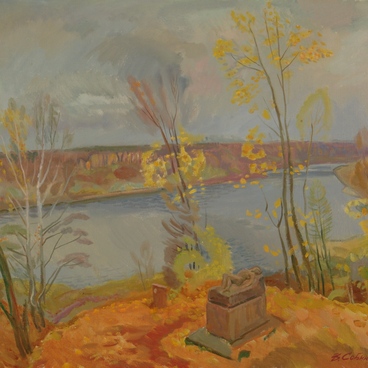‘The Memory’ (2008) is an artwork by painter and illustrator Boris Nikolaevich Malinkovsky (1929-2015), a member of the Union of Artists of Russia. He was the oldest teacher at the Moscow State Academic Art College (Homage to 1905), where he himself had previously studied to be a set designer. He received his second education as a monumental artist within the walls of Moscow State Stroganov Academy where such masters as Geliy Korzhev, Alexander Kuprin, Sergei Gerasimov became his mentors. He created monumental paintings and designed all-Union exhibitions for the All-Union Agricultural Exhibition (now VDNKh), worked as an illustrator of children’s books and at the Diafilm studio.
In the 1990s, he again turned to painting and worked productively, creating landscapes, portraits, still lifes. His later work “The Memory” from the collection of the Tarusa Art Gallery reflects Malinovsky’s artistic interests: painting by old European masters, in particular the Dutch still life of the 17th century, as well as the art of impressionism. Among his favorite artists were such masters as Monet, Renoir, Surikov, Serov, Velasquez, and Modigliani.
The square format of the painting was chosen for a reason. It gives the composition a sense of static and completeness. It depicts seemingly random objects of various purposes, shapes and textures, embodying the artist’s everyday life. Some of them reflect interests and artistic preferences, others illustrate spiritual values. There is a clearly depicted second volume of the catalog of the 1981 Moscow - Paris exhibition, which united the masterpieces of the Russian avant-garde and Picasso, Braque, Matisse, as well as the reconstruction of the Tower by Tatlin and El Lissitzky’s Tribune. An engraving by the prominent ukiyo-e master Kitagawa Utamaro " Pretty Osome from the house of Abura-ya’ (circa 1799) is depicted with exquisite skill. In the background, empty frames lean against the wall, probably symbolizing the incessant creative process. Nearby is a small portrait of St. Nil of Stolobensky. There is a St. George ribbon over it, which reflects the patriotic mood of the artist. The ficus in the East symbolizes well-being in the house.
In the 1990s, he again turned to painting and worked productively, creating landscapes, portraits, still lifes. His later work “The Memory” from the collection of the Tarusa Art Gallery reflects Malinovsky’s artistic interests: painting by old European masters, in particular the Dutch still life of the 17th century, as well as the art of impressionism. Among his favorite artists were such masters as Monet, Renoir, Surikov, Serov, Velasquez, and Modigliani.
The square format of the painting was chosen for a reason. It gives the composition a sense of static and completeness. It depicts seemingly random objects of various purposes, shapes and textures, embodying the artist’s everyday life. Some of them reflect interests and artistic preferences, others illustrate spiritual values. There is a clearly depicted second volume of the catalog of the 1981 Moscow - Paris exhibition, which united the masterpieces of the Russian avant-garde and Picasso, Braque, Matisse, as well as the reconstruction of the Tower by Tatlin and El Lissitzky’s Tribune. An engraving by the prominent ukiyo-e master Kitagawa Utamaro " Pretty Osome from the house of Abura-ya’ (circa 1799) is depicted with exquisite skill. In the background, empty frames lean against the wall, probably symbolizing the incessant creative process. Nearby is a small portrait of St. Nil of Stolobensky. There is a St. George ribbon over it, which reflects the patriotic mood of the artist. The ficus in the East symbolizes well-being in the house.



